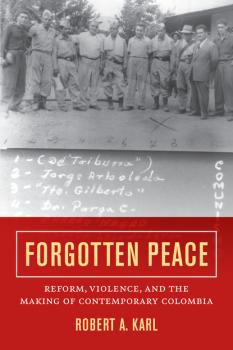Violence in Latin American History
Скачать книги из серии Violence in Latin American HistoryForgotten Peace
Forgotten Peace examines Colombian society’s attempt to move beyond the Western Hemisphere’s worst mid-century conflict and shows how that effort molded notions of belonging and understandings of the past. Robert A. Karl reconstructs encounters between government officials, rural peoples, provincial elites, and urban intellectuals during a crucial conjuncture that saw reformist optimism transform into alienation. In addition to offering a sweeping reinterpretation of Colombian history—including the most detailed account of the origins of the FARC insurgency in any language—Karl provides a Colombian vantage on global processes of democratic transition, development, and memory formation in the 1950s and 1960s. Broad in scope, Forgotten Peace challenges contemporary theories of violence in Latin America.
A History of Infamy
A History of Infamy explores the broken nexus between crime, justice, and truth in mid-twentieth-century Mexico. Faced with the violence and impunity that defined politics, policing, and the judicial system in post-revolutionary times, Mexicans sought truth and justice outside state institutions. During this period, criminal news and crime fiction flourished. Civil society’s search for truth and justice led, paradoxically, to the normalization of extrajudicial violence and neglect of the rights of victims. As Pablo Piccato demonstrates, ordinary people in Mexico have made crime and punishment central concerns of the public sphere during the last century, and in doing so have shaped crime and violence in our times.
Death in the City
At the turn of the twentieth century, many observers considered suicide to be a worldwide social problem that had reached epidemic proportions. In Mexico City, violent deaths in public spaces were commonplace in a city undergoing rapid modernization. Crime rates mounted, corpses piled up in the morgue, and the media reported on sensational cases of murder and suicide. More troublesome still, a compelling death wish appeared to grip women and youth. Drawing on a range of sources from judicial records to the popular press,<I> Death in the City </I>investigates the cultural meanings of self-destruction in modern Mexico. The author examines responses to suicide and death and disproves the long-held belief that Mexicans possess a cavalier attitude toward suffering.
Uruguay, 1968
The tumultuous 1960s saw a generation of Latin American youth enter into political life in unprecedented numbers. Though some have argued that these young-radical movements were inspired by the culture and politics of social movements burgeoning in Europe and the United States, youth activism developed its own distinct form in Latin America. In this book, Vania Markarian explores how the Uruguayan student movement of 1968 shaped leftist politics in the country for decades to come. She considers how students invented their own new culture of radicalism to achieve revolutionary change in Uruguay and in Latin America as a whole. By exploring the intersection of activism, political violence, and youth culture, <I>Uruguay, 1968</I> offers new insights about such subjects as the “New Left” and “Revolutionary Left” that are central to our historical understanding of the 1960s across the globe.
While the City Sleeps
While the City Sleeps is an extraordinary work of scholarship from one of Argentina’s leading historians of modern Buenos Aires society and culture. In the late nineteenth century, the city saw a massive population boom and large-scale urban development. With these changes came rampant crime, a chaotic environment in the streets, and intense class conflict. In response, the state expanded institutions that were intended to bring about social order and control. Lila Caimari mines both police records and true crime reporting to bring to life the underworld pistoleros, the policemen who fought them, and the crime journalists who brought the conflicts to light. In the process, she crafts a new portrait of the rise of one of the world’s greatest cities.
Argentina's Missing Bones
Argentina’s Missing Bones is the first comprehensive English-language work of historical scholarship on the 1976–83 military dictatorship and Argentina’s notorious experience with state terrorism during the so-called dirty war. It examines this history in a single but crucial place: Córdoba, Argentina’s second largest city. A site of thunderous working-class and student protest prior to the dictatorship, it later became a place where state terrorism was particularly cruel. Considering the legacy of this violent period, James P. Brennan examines the role of the state in constructing a public memory of the violence and in holding those responsible accountable through the most extensive trials for crimes against humanity to take place anywhere in Latin America.





